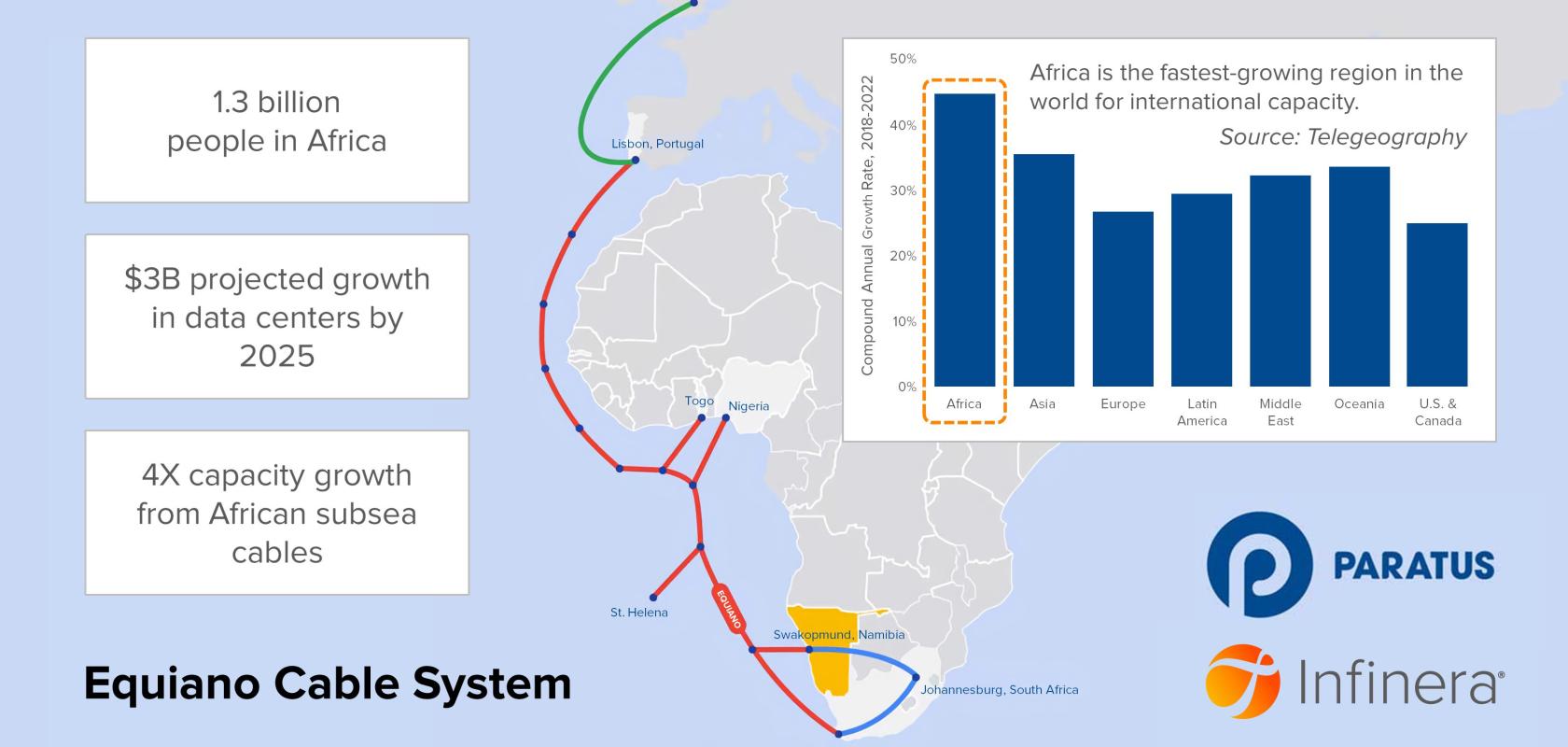Historically, the continent of Africa has lagged behind the rest of the world in terms of fibre network and broadband connectivity. While countries like South Africa and Egypt have greater connectivity according to global trade body GSMA, only 28% of the population of sub-Saharan Africa had mobile internet access in 2020, compared with 49% globally. Even with 18% of the world’s population, Africa has only 1% of the world’s data centre capacity, and data centre capacity and submarine network capacity in a given region are highly synergistic.
In 2020, a report by the International Finance Corporation described a $180B internet economy future for Africa, highlighting one of the largest overlooked investment opportunities in the world today.
Between 2018 and 2020, Africa enjoyed a compound annual growth rate (CAGR) for bandwidth of 44%, with at least eight new submarine cables from all points of the compass planned in the next couple of years, including PEACE, 2Africa, IEX, and Equiano. The capacity delivered by these cables is expected to significantly contribute to the projected $180bn growth in Africa’s GDP by 2025, potentially enhancing the lives of over 1.3 billion people.
The Equiano subsea cable system
Equiano is the third private international cable owned by Google and the 14th subsea cable invested in by the company. The system connects Sesimbra, Portugal to Cape Town, South Africa with branching units to Lagos, Nigeria; Lomé, Togo; Swakopmund, Namibia; Rupert's Bay, Saint Helena; and other locations. Cables like Equiano are leading the way in terms of submarine cable design, with the inclusion of many branching units delivering capacity into multiple West African nations.
Moreover, Equiano is a state-of-the-art submarine cable system based on a cable architecture called space-division multiplexing (SDM). SDM cables are designed to support higher numbers of fibre pairs compared to earlier cable designs. In the case of Equiano, this means 12 fibre pairs with a design capacity of 144Tb/s.
Paratus: Branching into Namibia
Namibia ranks 16th out of 55 countries in the Global Data e-Connectivity Index for 2021, suggesting that Namibia’s people have had a taste of the economic and social benefits that connectivity can bring based on existing infrastructure, but are keen to increase their access to more ubiquitous and advanced services. This is exactly the capability that Equiano can deliver via its branching unit that feeds capacity directly into Swakopmund.
Using Infinera’s ICE6 technology, Paratus has become the first network operator to light fibres and offer services over this Equiano branch. A “born and bred” African network operator, Paratus has physical infrastructure in seven African countries and a satellite network delivering connectivity to more than 35 countries across the continent. Crucially, this network includes a terrestrial route into South Africa built by Paratus and known as the Trans-Kalahari Highway. Coupled with the new subsea route, this provides vital resilience in the case of disruption on either route.
Schalk Erasmus, CEO of the Paratus Group, explained, “Paratus has worked with Infinera for a number of years on other projects and this partnership enables us to provide connectivity that is 20 times faster in capacity, with a solution that is modern and flexible to ensure economies of scale as well as offer efficiency in the services that the Paratus Group provides throughout its seven operating countries.”
ICE6 and SDM cables for subsea
SDM cables are designed to maximise total capacity on the cable, as opposed to earlier cable architectures that maximise capacity on individual fibre pairs. While this may seem like a trivial distinction, it means, for example, that SDM fibre pairs operate with lower amplifier gain and are built using fibres with smaller effective areas than previous designs.
Infinera’s ICE6 technology includes several unique features that help deliver the highest like-for-like capacity of any submarine transponder available today – including over SDM cables. In particular, the use of very long codewords in Infinera’s probabilistic constellation shaping modulation results in a higher tolerance to the amplifier spontaneous emission noise in the submarine repeater chain.
While Infinera’s ICE6 Turbo, at 100GBd, offers the highest baud rate of any commercial transponder, a key capability is to be able to tune this baud rate in order to optimise spectral efficiency across the SDM fibre spectrum.
Using a combination of advanced features in ICE6 can deliver 10-20% more capacity over a given fibre pair compared to other fifth-generation transponders.
Advantage Paratus
Being the first to light a new and highly advanced cable branch, along with the leading-edge performance of Infinera’s ICE6 optical engine, gives Paratus a crucial advantage in the rapidly expanding African market.


